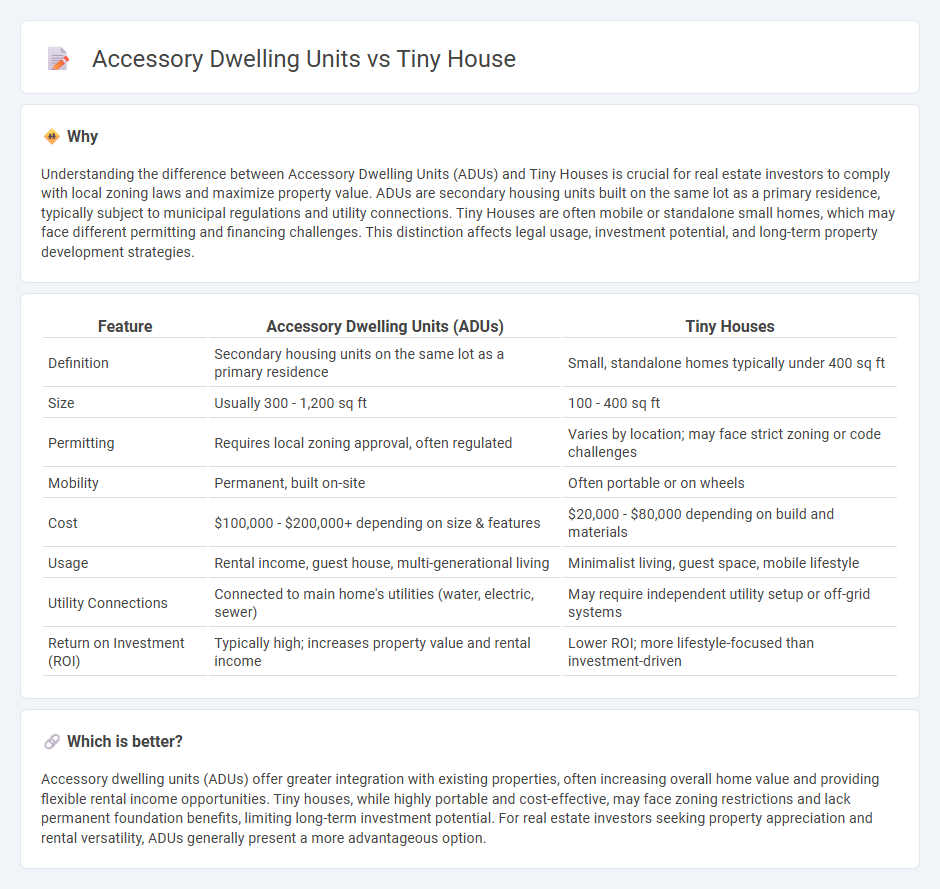
Accessory dwelling units (ADUs) are secondary housing units built on the same lot as a primary residence, often used to increase property value and provide rental income. Tiny houses, typically under 400 square feet, emphasize minimalism and affordability, appealing to those seeking a sustainable lifestyle or simplified living. Explore the distinct benefits and legal considerations of ADUs versus tiny houses to determine the best fit for your housing goals.
Why it is important
Understanding the difference between Accessory Dwelling Units (ADUs) and Tiny Houses is crucial for real estate investors to comply with local zoning laws and maximize property value. ADUs are secondary housing units built on the same lot as a primary residence, typically subject to municipal regulations and utility connections. Tiny Houses are often mobile or standalone small homes, which may face different permitting and financing challenges. This distinction affects legal usage, investment potential, and long-term property development strategies.
Comparison Table
| Feature | Accessory Dwelling Units (ADUs) | Tiny Houses |
|---|---|---|
| Definition | Secondary housing units on the same lot as a primary residence | Small, standalone homes typically under 400 sq ft |
| Size | Usually 300 - 1,200 sq ft | 100 - 400 sq ft |
| Permitting | Requires local zoning approval, often regulated | Varies by location; may face strict zoning or code challenges |
| Mobility | Permanent, built on-site | Often portable or on wheels |
| Cost | $100,000 - $200,000+ depending on size & features | $20,000 - $80,000 depending on build and materials |
| Usage | Rental income, guest house, multi-generational living | Minimalist living, guest space, mobile lifestyle |
| Utility Connections | Connected to main home's utilities (water, electric, sewer) | May require independent utility setup or off-grid systems |
| Return on Investment (ROI) | Typically high; increases property value and rental income | Lower ROI; more lifestyle-focused than investment-driven |
Which is better?
Accessory dwelling units (ADUs) offer greater integration with existing properties, often increasing overall home value and providing flexible rental income opportunities. Tiny houses, while highly portable and cost-effective, may face zoning restrictions and lack permanent foundation benefits, limiting long-term investment potential. For real estate investors seeking property appreciation and rental versatility, ADUs generally present a more advantageous option.
Connection
Accessory dwelling units (ADUs) and tiny houses both offer affordable, space-efficient housing solutions that maximize property use and increase residential density. ADUs are secondary living spaces attached or detached from the main home, often subject to local zoning regulations similar to those governing tiny house placements. Both concepts support sustainable living trends by providing flexible, low-impact housing options that address urban housing shortages and promote multi-generational living.
Key Terms
Zoning Regulations
Zoning regulations play a critical role in distinguishing tiny houses from accessory dwelling units (ADUs), often dictating allowable size, placement, and usage to control density and neighborhood character. While tiny houses are typically considered mobile or independent structures, many zoning codes classify ADUs as permanent secondary residences attached or adjacent to a primary home, affecting their permitting process. Explore detailed zoning guidelines and compliance strategies to optimize your tiny living or ADU project.
Minimum Square Footage
Tiny houses typically range from 100 to 400 square feet, emphasizing compact, efficient living spaces designed for mobility and minimalism. Accessory dwelling units (ADUs) usually start at around 400 square feet and can extend up to 1,200 square feet, offering more flexibility for permanent housing or rental income on an existing property. Explore detailed comparisons and zoning regulations to determine which option suits your space and lifestyle needs.
Primary Residence
Tiny houses, typically under 400 square feet, serve as compact primary residences that maximize efficient living in limited space. Accessory dwelling units (ADUs) function as secondary housing units on the same property as a primary residence but are not designed to replace it. Explore the benefits and regulations surrounding tiny houses and ADUs to determine the ideal primary residence solution for your needs.
Source and External Links
Tiny-house movement - Wikipedia - The tiny-house movement promotes living in homes typically under 400 to 600 square feet, focusing on simplified, lower-cost, and sometimes eco-friendly living, with various styles including mobile and fixed tiny homes that face legal and practical challenges but serve diverse needs like downsizing, disaster relief, and homelessness aid.
Unique One-Level Tiny Home Tour for Easy Living - YouTube - A tour showcasing a beautifully designed, comfortable one-level tiny home that maximizes storage and indoor-outdoor living despite common misconceptions about tiny house limitations.
Tiny House Blog - Offers stories and insights about different tiny house styles, communities, and lifestyles, highlighting the rich character and connection with what matters most through tiny living, including features on tiny home builders and unique tiny house examples.
 dowidth.com
dowidth.com